In-situ nitrogen fate in the vadose zone of different soil types and its implications for groundwater quality in the Huaihe River Basin,China
2020-06-22RongfuLiXiaohongRuanTianhaiMaYingBaiCongqiangLiu
Rongfu Li·Xiaohong Ruan·Tianhai Ma·Ying Bai·Congqiang Liu
Abstract This paper focused on nitrate fate in the vadose zone (VZ) and its implications for groundwater vulnerability under different soil types in the agricultural area of Huaihe River Basin,China.Isotopic compositions of nitrate (δ15N and δ18O) along with NO3- and Cl- concentrations were determined in the VZ-shallow groundwater continuum beneath silty-loam and silty-clay-loam,which are distinctive in texture and organic carbon (OC).In the soil zone (<1 m in depth),measured δ18O–NO3-suggested the ubiquitous of nitrification regardless of soil types.In the subsoil zone (>1 m in depth),however,the concurrent enrichment of δ15N–NO3- and δ18O–NO3-indicated the occurrence of denitrification,which showed a dependence on subsoil properties.Specifically,during wheat and maize land uses,denitrification removed as much as 76 %–88 % of the total nitrate where the subsoil was dominated by stratified OC-rich silty-clay-loam.In contrast,only 0 %–28 % of the nitrate was degraded via denitrification where the subsoil was composed of uniform,OC-depleted silty-loam.Furthermore,inactive denitrification and higher permeability in the silty-loam VZ implied higher groundwater vulnerability.This observation was consistent with the fact that groundwater NO3-–N concentration beneath silty-loam (11.24 mg L-1) was over two times higher than that of the silty-clay-loam(5.32 mg L-1),where stricter fertilization management and conservation strategies should be applied to protect groundwater quality.
Keywords Vadose zone·Silty-loam·Silty-clay-loam·Nitrogen transformation·Groundwater vulnerability·Stable isotopes
1 Introduction
Excessive use of agricultural nitrogen (N) fertilizer has resulted in the dramatic increase of nitrate accumulation in soil profiles (Ascott et al.2017),groundwater (Gu et al.2013),and surface water(Donner and Kucharik 2003),and thus resulted in a global environmental concern (Rivett et al.2008).Vadose zone(VZ)is an important pathway for topsoil N to transport from the land surface into the aquifer and plays a critical role in N storage (Ascott et al.2017)and transformations (Holden and Fierer 2005).As such,a clear understanding of N behavior in the VZ will facilitate the understanding of groundwater vulnerability for nitrate pollution.
For the biogeochemical transformations of N in the VZ,numerous laboratory soil incubations have been carried out to explore N transformation microorganism (Holden and Fierer 2005),and kinetics such as mineralization (Bonde and Lindberg 1988),nitrification (Koper et al.2010),denitrification (Liu et al.2010),and anammox (Zhu et al.2018).For N transport and leaching processes in the VZ,the most commonly used methods were soil-column experiment (González-Delgado and Shukla 2011) and lysimeters (Rasse et al.2000).However,these laboratory studies provide no insights into the in-situ behavior of N,and soil-column/lysimeters rarely cover the entire VZ,and thus could not provide a full understanding of the in-situ N fate in the VZ and its impact on groundwater.
One of the strategies to overcome the deficiency of laboratory studies is to carry out field observations using the stable isotopic technique (Singh et al.2018; Stumpp et al.2018).Based on the dual-isotopic signature of nitrate(δ15N and δ18O)and the isotopic fractionation,the major N transformation pathways in the VZ and N sources in the groundwater could be traced in-situ (Denk et al.2017).This method was proved robust under various environments,such as croplands (McMahon et al.2006),waste lagoons (Baram et al.2012),riparian zone (Yuan et al.2012),alluvial deposits (Izbicki et al.2015),and Loess Plateau(Jia et al.2018).These studies have revealed that N fate in the VZ was mainly controlled by N inputs and irrigation regimes,climatic conditions,and VZ material properties such as carbon and nitrogen availability,soil particle size fractionation,and texture.
China is dependent on agricultural production and numerous soil types are used for this purpose,including 12 orders,30 suborders,60 groups according to the Classification and Codes for Chinese Soil (GB 17296-2009).Past work on VZ N behavior of the agricultural area mainly focused on limited soil types such as alluvial deposits(Yuan et al.2012),sandy-silt and silty-sand (Zhang et al.2012),and Loess Plateau (Jia et al.2018).These previous studies have suggested high denitrification potential in fineparticle alluvial deposits,while denitrification was rare in the VZ with coarse particle size.Due to the great complexity and site-specificity of climate,soils,biomass,parent material,and soil-forming processes (Gray et al.2011;Bünemann et al.2018),an in-situ assessment on N fate in the VZ and its impact on groundwater under integrated soil and climatic conditions is essential to better reveal groundwater vulnerability and appropriate land management practices.
In the present study,we attempt to examine the fate of VZ N and its implications for groundwater vulnerability beneath two representative soil types,Fluvo-aquic Soil(FAS)and Lime-concretion Black Soil(LCBS).These two soil types make up 34%and 13%respectively of the total arable land in the Huaihe River Basin,the stratification and OC contents of the LCBS is substantially different to that of the FAS (Fig.1a).Multi-isotope technique was used to trace the in-situ N transformation pathways.It was found that the uniform,OC-depleted silty-loam (FAS) did not support the denitrification process in the subsoil zone below 1 m,resulting in higher groundwater vulnerability,which could provide rational guidance for improved fertilization under different soil types.
2 Materials and methods
2.1 Study area and sampling methods
The Huaihe River Basin (HRB) is one of the core agricultural areas in China,with major crop types of maize and wheat rotation.The HRB accounts for 17 %of the national grain production using 10 % of the national arable land,which has been achieved through substantial increases in the use of synthetic fertilizers of urea,ammonium phosphate,and potassium sulfate containing N,P,and K as high as~650,110,and 50 kg ha-1year-1.Chemical fertilizer was mainly applied in June and October when maize and wheat were drilled.
Fluvo-aquic Soil (FAS,site A) is semi-hydro morphic soil developed form alluvial sediment with a homogeneous silty-loam parent and is depleted with OC.In contrast,Lime-concretion Black Soil (LCBS,site B) is a river or lake alluvial deposit composed of a major silty-loam parent with interbedded silty-clay-loam,which is richer in clay(Fig.1b,c).According to the hydrogeological boreholes to the depth of~12 m,the first aquifers beneath the VZ at both sites were mainly composed of sandy clay loam,with a buried depth of 3.1–5.2 m and 3.5–7.5 m (Fig.1c).The lower confining bed was an impermeable clay/silty-clay stratum with a thickness of~6.2 and~4.5 m.
Annual precipitation and mean pan evaporation in the study area were 862.5 and 1008.3 mm(https://yc.wswj.net/ahsxx/LOL/public/public.html),with 50 %–80 % of the precipitation falls during maize land use (from June to September)(Fig.1d).Depth to the water table at both sites was about 2.6 m in June,and was 2.7 and 2.2 m at site A and site B in September.
Soil-core sampling was conducted after the harvest of wheat (June) and maize (September) in 2014,representing the wheat land use(WLU)and the maize land use(MLU),respectively.A total of four soil cores were drilled using a 7.5 cm diameter hollow stem hand auger from land surface to the water table in silty-loam and silty-clay-loam areas(Fig.1a).Soil and subsoil were sampled continuously with an interval of 10 cm,homogenized,and sealed in polyethylene bags.
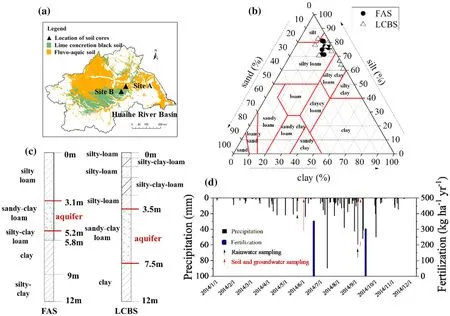
Fig.1 a Main soil types distribution,and sampling sites in the Huaihe River Basin,b VZ soil particle fractionation classification for Fluvo-aquic soil (FAS) and Lime concretion black soil (LCBS) according to soil classification of United States Department of Agriculture (USDA),c hydrogeological profiles of VZ-groundwater for FAS and LCBS from land surface to the depth of 12 m,d precipitation,fertilization,and sampling time during the study period
Groundwater from the first aquifers below the VZ was collected from completely penetrating wells with a screening depth of~10 m around the soil sampling sites(<50 m in distance).A total of 18 groundwater samples were collected from two and seven wells in site A and B respectively during the wheat and maize land uses.Before groundwater sampling,old water in the wells was pumped out to collect freshwater as much as possible.Groundwater parameters such as temperature(T),electrical conductivity(EC),pH,oxidation–reduction potential (ORP),and dissolved oxygen (DO) were continuously monitored during pumping using a multi-parameter water quality instrument(YSI ProPlus,USA).Groundwater samples were collected after the values of these parameters became constant.Two rainwater samples were collected during the rainfall event before soil-core and groundwater sampling (Fig.1d).All VZ materials,groundwater,and rainwater samples were placed in an icebox immediately and analyzed within 24 h.
2.2 Analytical methods
A minimum of 100 g of VZ material was dried at 105 °C for 12 h to determine the gravimetric moisture content(θg).VZ water extracts were obtained following the method described by Yuan et al.(2012).Briefly,200 g of VZ material was mixed with 200 mL of fresh deionized water,shaken for 30 min at room temperature,centrifuged at a rotation speed of 4000 rpm for 10 min,and then filtered through 0.22-μm cellulose-acetate filters.The rest of the VZ material was air-dried,grounded,sieved (200 mesh),and used for physicochemical parameters determination.
Anions (NO3-and Cl-)of VZ water extract,rainwater,and groundwater were analyzed by the ion chromatography(ICS-2000,Dionex,USA).VZ material particle size fractionation was determined by a laser scattering particle size analyzer (NANOSAQLA,Japan).Total nitrogen (TN) of the VZ materials was measured by the Kjeldahl method(BUCHI K-350 unit,Switzerland),and organic carbon(OC) was determined by the elemental analyzer (Flash Smart,Thermo Fisher,USA).Pore-water ion concentrations (Cpore-water) in the VZ were calculated based on Cpore-water=Cextract×,where Cextractis ion concentration in the VZ water extracts,and θgis the VZ material gravimetric moisture content.
The stable isotopic compositions of rainwater and groundwater (δD and δ18O,expressed as δ(‰ )=×1000) were obtained using a Finnigan (MAT-253).The δ15N and δ18O of NO3-were measured by an isotope ratio mass spectrometer(IsoPrime,GV,UK) using the ‘‘denitrifier method’’ (Sigman et al.2001; Casciotti et al.2002).Four international nitrate standards (USGS-32,USGS-34,USGS-35,and IAEA-N3)were used to calibrate the measured δ15N and δ18O data.Each sample was measured in triplicate.The Vienna standard mean ocean water (VSMOW) was used as the reference for D/H and18O/16O ratios,whereas average N2in the air was used to determine15N/14N ratios.
3 Results
3.1 Physical and chemical characteristics of VZ materials
The FAS has a silty loam soil texture in the entire VZ,and the content of clay varied within a narrow range (18.4% ± 2.3 %).In contrast,the LCBS has layers of silty loam texture(0–0.4,1.0–1.4,and 1.8–2.4 m)and silty clay loam texture layers (0.4–0.8,and 1.4–1.8 m) (Fig.2a,b).The clay content in the silty clay loam layers(34.4% ± 2.2 %)of LCBS was significantly higher (p <0.001,t test) than that in the corresponding depth of FAS profile (17.5% ± 2.6 %).Moreover,VZ material of silty-clay-loam was richer in TN (0.04 % ± 0.02 %) and OC(1.97% ± 0.39%),which were two-fold,and 2.5-fold higher than those (0.02 % ± 0.01 %,and 0.79% ± 0.34 %) of silty-loam (Fig.2c,d).
In the homogeneous VZ of silty-loam,measured θgvaried remarkably down the vertical profile (0.18 ± 0.05 in WLU and 0.20 ± 0.03 in MLU)(Fig.3a).In contrast,θgin the stratified VZ of silty-clay-loam showed less vertical variations(0.17 ± 0.02 in WLU and 0.19 ± 0.01 in MLU)(Fig.4a).Moreover,in the VZ of both sites,measured θgduring MLU was higher than that of WLU,which could be explained by higher precipitation during MLU (Fig.1d).

Fig.2 a,b profiles of VZ material particle size fractionation of FAS and LCBS,c total nitrogen content,and d organic carbon content
3.2 Nitrate and chloride concentrations in VZ and groundwater
In the soil zone (<1 m in depth),measured NO3-–N concentration exhibited an increasing trend except for that in silty-loam during MLU.In specific,NO3-–N concentration increased by over three-fold down the vertical profile of silty-clay-loam during both WLU and MLU(Fig.4c).In contrast,NO3-–N concentrations in the soil zone of silty-loam increased by 1.5-fold during MLU,but a reversed decreasing trend was observed for WLU(Fig.3c).
In the subsoil zones (>1 m in depth),however,measured NO3-–N concentration exhibited a decreasing trend except for that in silty-loam during WLU.Specifically,NO3-–N concentration decreased by over 90 %–70 %down the vertical profile of silty-clay-loam for WLU and MLU.While NO3-–N concentrations in the subsoil zone of silty-loam decreased by 70 % during MLU,but showed slight variation during WLU.
Moreover,a synchronous trend between Cl-and NO3-–N was found in the correspondence subsoil zone of siltyloam as the NO3-/Cl-molar ratios varied slightly(Fig.5b),but a decreasing trend of NO3-/Cl-was found in the subsoil zone of silty-clay-loam (Fig.5a).This observation implied NO3-–N concentration in the subsoil zone of silty-loam was dominantly controlled by physical processes such as evaporation and rainfall dilution,but might be affected by biogeochemical processes in the subsoil zone of silty-clay-loam.
One of the observations was that measured VZ NO3-–N concentration during MLU was significantly higher than that of the WLU at both sites(p <0.001,t test).This could be explained by the application of nitrogen fertilizer(~350 kg ha-1) in late June before sowing the maize.Fertilizer-derived nitrogen might be flushed downward to the soil and subsoil zone,resulting in higher NO3-–N concentration in the VZ during MLU.Moreover,NO3-–N concentration in the VZ of silty-clay-loam was much higher than that of the silty-loam.This might be caused by the stratified texture of silty-clay-loam which hindered nitrate infiltration,resulting in higher nitrate accumulation in the VZ profile.
Meanwhile,measured groundwater NO3-–N concentration beneath silty-loam (11.24 ± 4.78 mg L-1) was more than two times higher than that of the silty-clay-loam(5.32 ± 5.33 mg L-1).This observation coincided with lower nitrate and TN retention in the VZ of silty-loam.Moreover,NO3-–N concentration of 3/4 groundwater samples beneath the silty-loam exceeded the drinking water quality limit (10 mg L-1,EPA of China).In the silty-clay-loam area,however,only 2/14 of the groundwater samples exceeded this limit,suggesting higher groundwater vulnerability beneath the silty-loam.
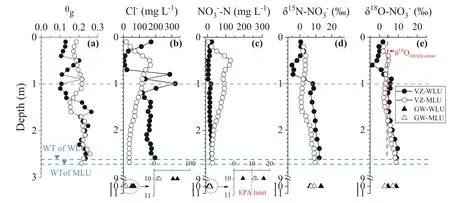
Fig.3 Vertical profiles of a θg,b Cl-,c NO3-–N,d δ15N–NO3-,e δ18O–NO3-in the VZ and groundwater(GW)beneath silty-loam during the wheat land use(WLU)and maize land use(MLU).The vertical red dashed line stands for the theoretical δ18O–NO3-derived from nitrification,and the horizontal blue dashed line stands for the water table (WT)
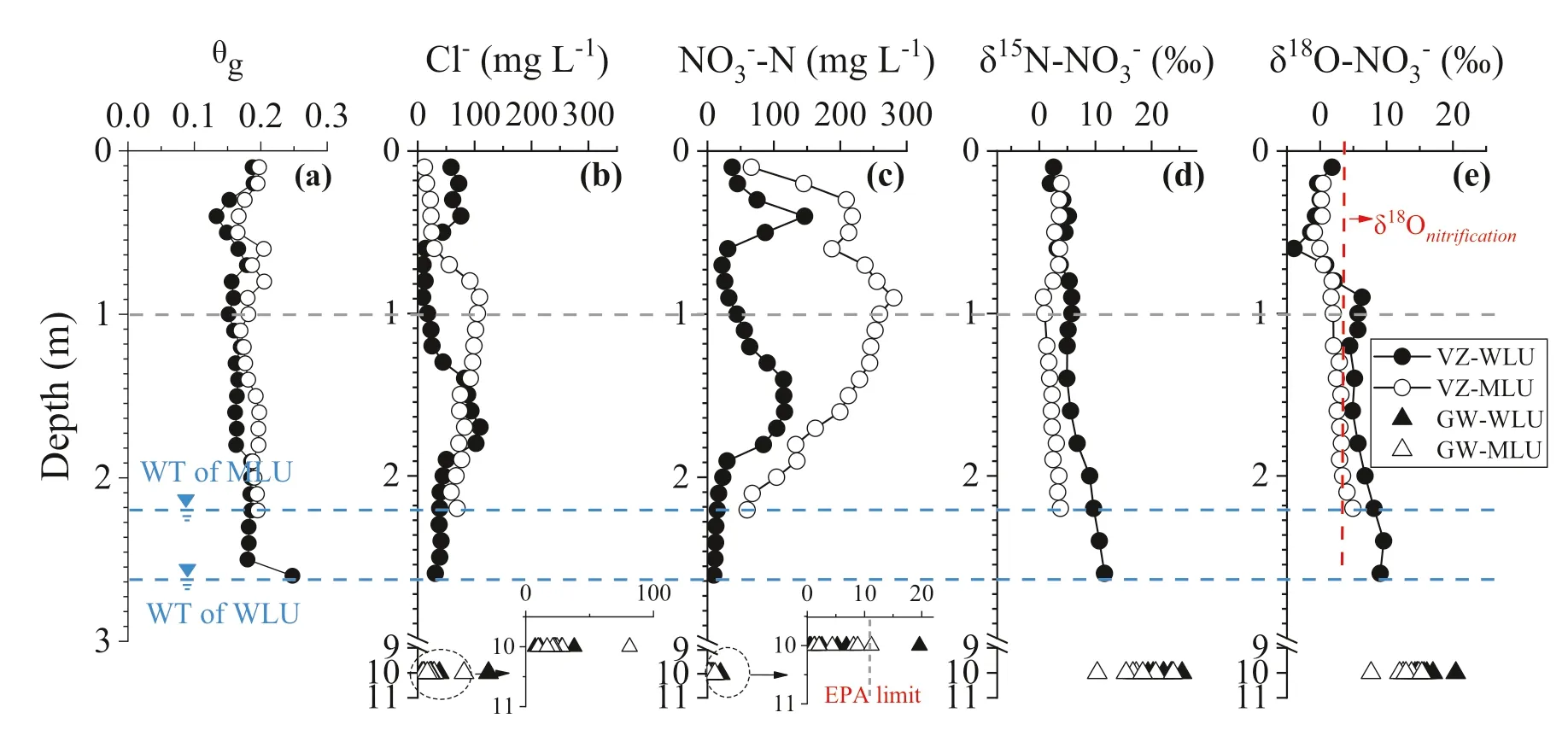
Fig.4 Vertical profiles of a θg,b Cl-,c NO3-–N,d δ15N–NO3-,e δ18O–NO3- in the VZ and GW beneath silty-clay-loam during the wheat land use(WLU)and maize land use(MLU).The vertical red dashed line stands for the theoretical δ18O–NO3-derived from nitrification,and the horizontal blue dashed line stands for the water table (WT)
3.3 Isotopic compositions of nitrate in VZ and groundwater
In the soil zones(<1 m in depth),isotopic compositions of nitrate varied within narrow ranges at both sites.In specific,average δ15N–NO3-and δ18O–NO3-values were 0 ± 3.9‰,1 ± 3.1‰(WLU),2.8 ± 0.7‰,3.5 ± 1.0‰(MLU)in the soil zone of silty-loam(Fig.3d,e).In the soil zone of silty-clay-loam,δ15N–NO3-and δ18O–NO3-were 4.2 ± 1.4 ‰,5.2 ± 1.5 ‰ (WLU),2.8 ± 1.2 ‰,0.7 ± 1.0 ‰ (MLU) respectively (Fig.4d,e).
In the subsoil zones(>1 m in depth),however,15N and18O were gradually enriched down the vertical profile at both sites.Specifically,measured δ15N and δ18O enriched by 6.5 to 7.4‰(WLU),and 3.0 to 3.2‰(MLU)in subsoil zone of silty-clay-loam,and increased by 3.5 to 2.8 ‰(WLU),and 7.8 to 2.0‰ (MLU) in subsoil zone of siltyloam.
Meanwhile,in silty-clay-loam area,groundwater NO3-was more rich with heavy isotopes(δ15N=19.9 ± 4.1‰,δ18O=14.4 ± 2.9 ‰) than those in the silty-loam area(δ15N=8.9 ± 3.1 ‰,δ18O=5.8 ± 2.7 ‰) (Table 1).
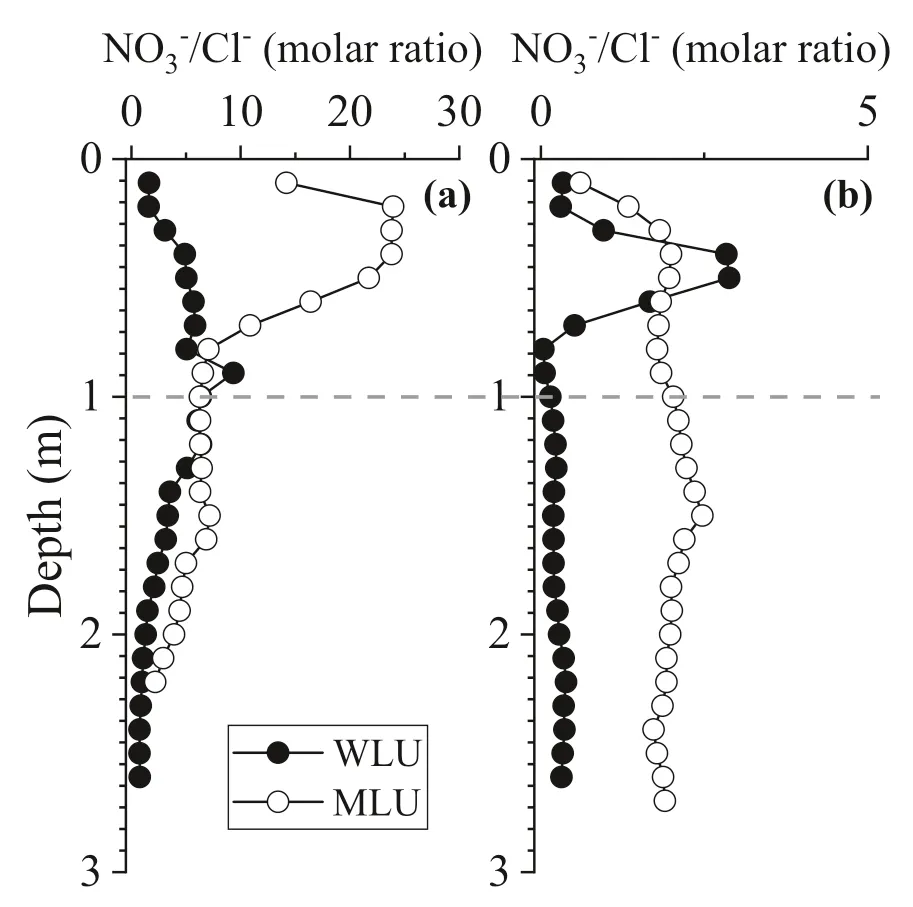
Fig.5 Vertical profiles of NO3-/Cl- molar ratios in the VZ of a silty-clay-loam,and b silty-loam during the wheat land use (WLU)and maize land use (MLU)
4 Discussions
4.1 Nitrification in the vertical profile of the VZ
The traditional nitrification pathway suggests that 1/3 of the oxygen atoms in NO3-comes from atmospheric O2(δ18Oair=23.5 ‰),while the rest comes from the surrounding H2O (Snider et al.2010).Therefore,the theoretical δ18O value(δ18Onitrification)of nitrification-produced NO3-could be estimated based on the stoichiometric equation below:

In the study area,water in the soil zone(<1 m in depth)was mainly derived from precipitation and groundwater irrigation.Due to the similarity of oxygen isotopic signature between rainwater (δ18ORW=-6.6 ‰) and groundwater (δ18OGW=-7.6 ‰ in the silty-loam area,and-7.2‰ in the silty-clay-loam area),δ18Osoilwaterwas estimated using the average isotope value of rainwater and groundwater.As such,the δ18Onitrificationwas calculated to be 3.1‰(soil zone of silty-loam) and 3.2‰(soil zone of silty-clay-loam) based on Eq.(1).Measured δ18O–NO3-values in the soil zones of silty-loam (1.0 ± 3.1 ‰ and 3.5 ± 1.0 ‰) and silty-clay-loam (5.2 ± 1.5 ‰ and 0.7 ± 1.0 ‰) varied around the δ18Onitrificationvalues(Figs.3e,4e),suggesting the ubiquitous of nitrification in the soil zones regardless of soil types.The wider range of measured δ18O–NO3-than the δ18Onitrificationmaybe explained by the isotopic fractionation of δ18Osoilwaterand δ18Oaircaused by evaporation and root respiration (Xue et al.2009).
The molar ratios of NO3-to Cl-could verify the nitrification processes due to the inertness of Cl-in biochemical reactions (Liu et al.2006).In the soil zones,NO3-/Cl-gradually increased from 0.34 to 2.88 (WLU)and 0.60 to 1.99 (MLU) beneath the silty-loam,and increased from 1.62 to 9.35 (WLU) and from 14.19 to 23.96 (MLU) beneath the silty-clay-loam (Fig.5).This observation implied the surplus of nitrate relative to chloride in the soil zone at both sites,further confirmed the occurrence of nitrification which contributed to soil nitrate pool.The ubiquitous nitrification process in the soil zones may facilitate nitrate leaching because of the higher mobility of nitrate in the VZ (Di and Cameron 2016).
4.2 Denitrification in the vertical profile of the VZ
4.2.1 Denitrification process identification
It is commonly realized that denitrifiers preferentially use light isotopes(14N and16O),resulting in the enrichment of heavy isotopes (15N and18O) in the residual nitrate pool along with the depletion of nitrate (Lehmann et al.2003).
In the subsoil zone(>1 m in depth) of silty-clay-loam,both δ15N and δ18O gradually increased (Fig.4c,d) along with the dramatic decrease of NO3-/Cl-from 6.07 to 0.78(WLU)and from 6.28 to 2.19(MLU)(Fig.5a).In addition,the isotopic fractionation ratios of δ18O to δ15N were 1:1.2(p <0.001) during WLU and 1:1.1 (p=0.002) during MLU (Fig.6a),which were approximate to the reported denitrification isotope fractionation range of 1:1–1:2(Hosono et al.2013; Li et al.2017).These findings demonstrably confirmed that denitrification was the dominant process leading to the enrichment of15N and18O in the subsoil zone of silty-clay-loam.

Table 1 Concentrations of DO,NO3-–N,isotopic compositions of NO3- and H2O in groundwater beneath the silty-loam (n=4),silty-clayloam (n=14),and rainwater (n=2) during the study period
In the corresponding subsoil zone of silty-loam,both δ15N and δ18O increased slightly down the vertical profile regardless of crope types,with δ18O to δ15N fractionation ratios of 1:1.1 (p <0.001) in WLU and 1:1.6 (p <0.001)in MLU (Fig.6b).On the contrary,no dramatic variations of NO3-/Cl-ratios were observed down the vertical profile(Fig.5a).Specifically,in MLU,calculated NO3-/Clmolar ratios decreased mildly from 2.47 to 1.73,but an inverse slightly increasing trend (from 0.04 to 0.39) was observed during WLU (Fig.5b).These observations indicated that denitrification occurred during MLU but was absent during WLU.
4.2.2 Denitrification efficiency estimation
To further quantify the efficiency of denitrification in the subsoil zone,isotope enrichment factors(ε)of15N and18O during denitrification were estimated based on the linear relationships of δ15N–NO3-,δ18O–NO3-and ln(NO3-/Cl-)using the modified Rayleigh Equation(Li et al.2018).The NO3-/Cl-molar ratios were used to eliminate the influence of physical processes (evaporation/precipitation)on nitrate concentration in the VZ.where δsamplingand δinitialare the isotopic compositions of nitrate at the sampling time and the initial time (when nitrate was formed and denitrification did not occur yet to affect the isotopic compositions of nitrate),ε stands for the isotope enrichment factor,andandare NO3-/Cl-molar ratios at the sampling and initial time.

In the subsoil zone of silty-clay-loam,ln(NO3-/Cl-)was significantly correlated to δ15N–NO3–(p <0.001)and δ18O–NO3-(p <0.001) of both land uses (Fig.7a).Calculated ε values for15N and18O were 3.3 and 2.9 ‰(WLU),and 1.8 and 1.9 ‰ (MLU) based on the Rayleigh distillation kinetics (i.e.,a closed nitrate pool being consumed with a constant N-isotope effect) (Lehmann et al.2007).In the corresponding subsoil zone of silty-loam,however,such linear correlations (p <0.001) were only observed during MLU (Fig.7b),and ε values for15N and18O were 25.6 and 13.1 ‰ respectively.
Furthermore,the calculated ε values were used to estimate denitrification efficiency (1-) using Eq.(2).The most depleted15N and18O ratios and high NO3-/Cl-molar ratios at the depth of 1.5 m in silty-loam VZ and 1.2 min silty-clay-loam VZ were assumed to represent the original isotopic compositions of nitrate (δinitialin Eq.(2)) before denitrification.Calculations of the denitrification efficiency (1-) based on Eq.(2)showed that as much as 76 %–88% of the total nitrate(mainly derived from nitrification end-product of fertilizer and soil nitrogen prior to denitrification) was removed during WLU and MLU via denitrification in the subsoil zone of silty-clay-loam.While in the subsoil zone of siltyloam,denitrification was only observed during MLU with the nitrate removal efficiency of 28 %.This difference in denitrification removal efficiency between silty-loam and silty-clay-loam profiles is in agreement with the observations of lesser groundwater nitrate problems under clayey vadose zones (Kurtzman et al.2016).
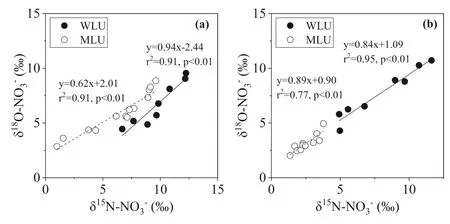
Fig.6 Scatter plots of δ18O–NO3- versus δ15N–NO3- in the subsoil zone (>1 m in depth)beneath a silty-clay-loam,and b silty-loam during wheat land use (WLU) and maize land use(MLU)
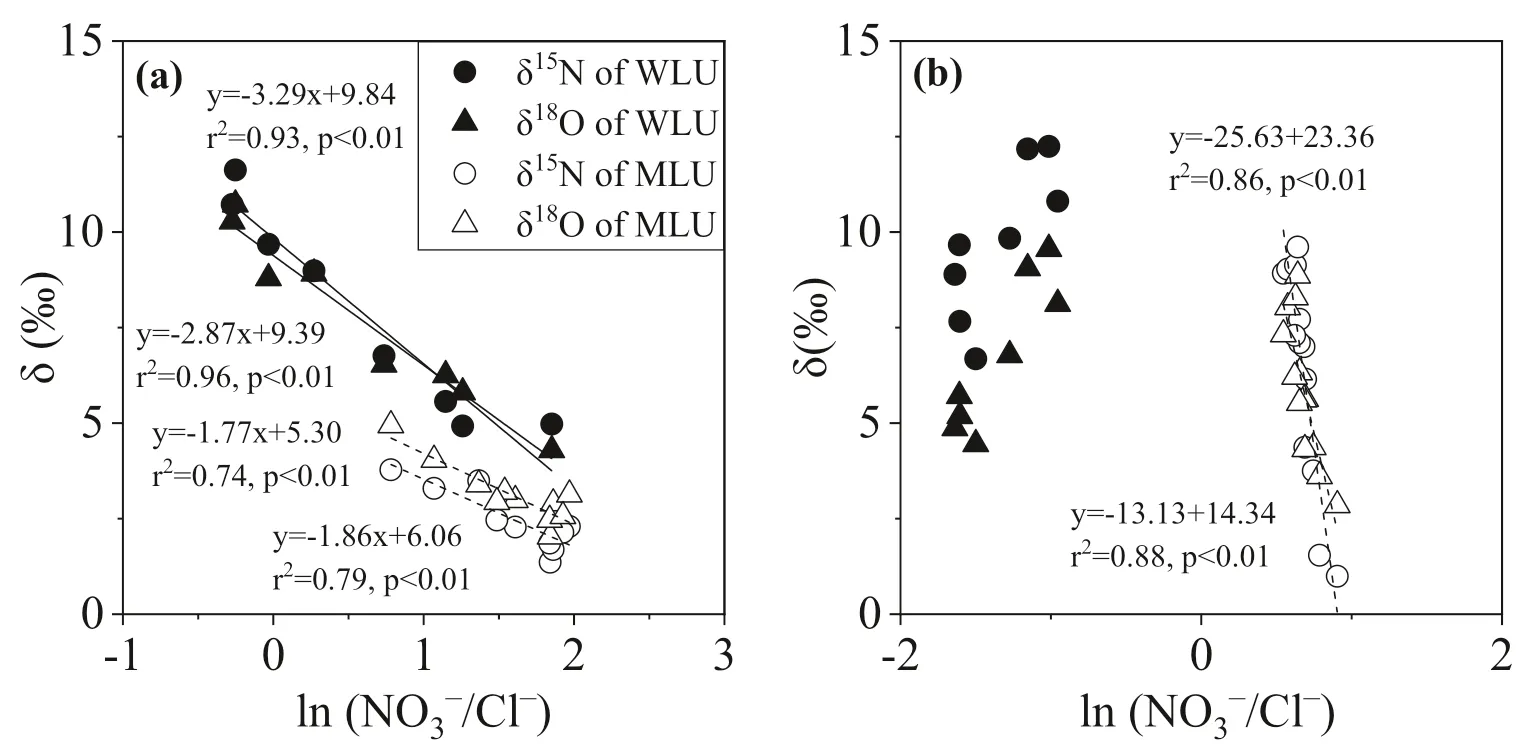
Fig.7 Scatterplots of δ15N–NO3- and δ18O–NO3- versus ln(NO3-/Cl-) in the subsoil zone(>1 m in depth)of a siltyclay-loam and b silty-loam during the wheat land use(WLU) and maize land use(MLU)
4.2.3 Influencing factors of denitrification efficiency
The observed difference of denitrification efficiency in the subsoil zone between silty-loam and silty-clay-loam could be explained by the subsoil properties and VZ texture stratification.It’s reported that nitrate concentration,electron donors,and redox conditions are the key factors controlling the denitrification process (Rivett et al.2008;Zhou et al.2017).In the subsoil zone of silty-clay-loam,NO3-–N concentrations(54.61 and 170.46 mg L-1during WLU and MLU) and OC (1.85%) were over two times higher than nitrate (16.97 and 49.59 mg L-1during WLU and MLU)and OC(0.81%)of silty-loam.Higher substrate content facilitated the denitrification process in the siltyclay-loam profile.Furthermore,compared with silty-loam VZ,the silty-clay-loam VZ with more vertical stratification might create anoxic interfaces beneficial for denitrifiers(Bradshaw and Radcliffe 2013).
4.3 Implications of VZ nitrogen transformations for groundwater quality
4.3.1 Groundwater nitrate sources identification
The fate of nitrogen in the VZ may significantly affect the groundwater quality(Spalding and Exner 1993;Yuan et al.2012).In this study,measured δ18O–NO3-signatures suggested that nitrate in the VZ beneath both soil types was mainly derived from the nitrification end-product of nitrogen fertilizer and soil nitrogen (Fig.8).
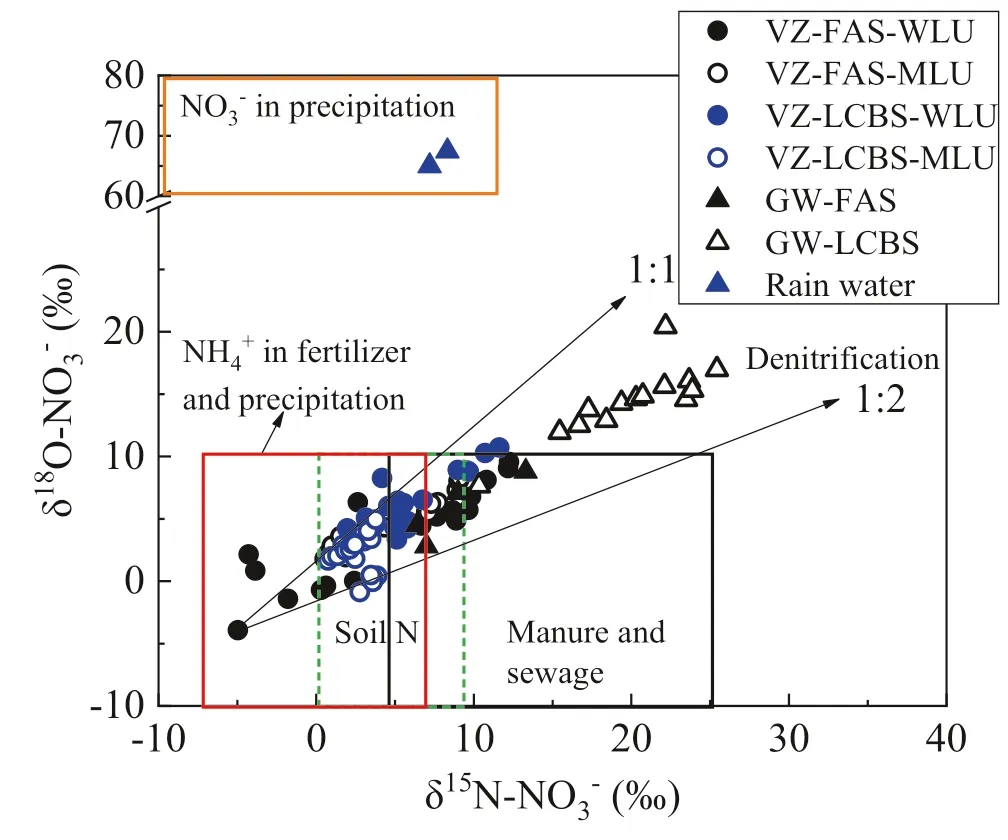
Fig.8 Cross-plots of δ18O–NO3- versus δ15N–NO3- in the vadose zone(VZ),groundwater(GW),rainwater,and various nitrate sources.WLU and MLU represent wheat land use and maize land use,respectively.Two dashed lines with arrows represent δ18O to δ15N fractionation ratios of 1:1 and 1:2 during denitrification.The boxes represent the isotopic compositions of various nitrate sources modified from Xue et al.(2009)
In the groundwater beneath the silty-loam,measured δ15N–NO3-and δ18O–NO3-(δ15Nmean=8.9 ‰,δ18-Omean=5.8 ‰) were similar to those at the bottom of the VZ (Fig.3c,d),denoting that groundwater nitrate was mainly derived from VZ leaching recharge.In the groundwater beneath the silty-clay-loam,however,isotopic compositions of nitrate (δ15Nmean=19.9 ‰,δ18Omean-=14.4‰)were two times higher than those at the bottom of the VZ,indicating that the VZ leaching-derived nitrate had also undergone intensive denitrification in the aquifer.Higher denitrification potential in the groundwater beneath silty-clay-loam may be explained by lower DO concentration (1.63 mg L-1) than that beneath silty-loam(4.74 mg L-1) (Rivett et al.2008).
4.3.2 Groundwater nitrate vulnerability and its influencing factors
Groundwater NO3-–N concentration beneath silty-loam was over two times higher than that in silty-clay-loam(11.24 vs.5.32 mg L-1),while average NO3-–N concentrations in the VZ of silty-loam (14.22 and 60.09 mg L-1)were much lower than those of silty-clay-loam (54.61 and 187.13 mg L-1).This might be explained by that groundwater nitrate vulnerability was not only correlated to NO3-–N concentration in VZ,but also determined by water percolation rate which was affected by precipitation,VZ texture and materials (Green et al.2008).Higher sand content and lower clay content of the silty-loam resulted in higher permeability,which could promote water percolation and nitrate leaching processes in the VZ (Green et al.2008; Bradshaw and Radcliffe 2013).
Moreover,it’s conceivable that the total nitrogen input(fertilizer,N precipitation,and N fixation) at two sites of the study area was approximately the same under the same land use.In the VZ of silty-loam,however,both denitrification efficiency and nitrogen retention(estimated as TN in Fig.2c) were lower than those in the VZ of silty-clayloam,resulting in higher nitrate leaching risk in silty-loam.Hence,it could be concluded that groundwater beneath the silty-loam VZ was more vulnerable due to the inactive denitrification and high permeability caused by OC-poor,coarse soil particles,and loose texture.While in-situ nitrate leaching flux of various soil types under global climate change should be simulated in further studies to provide quantitative guidance for rational fertilization.
5 Conclusions
Multi-isotope tracers were used to probe the behavior of fertilizer-derived nitrogen in the VZ-groundwater continuum,and to analyze the implications for groundwater vulnerability and rational fertilization in silty-loam and silty-clay-loam soils in the Huaihe River Basin.(1) Measured δ18O–NO3-value in the soil zone (<1 m in depth)was similar to the theoretical value of nitrification in all examined scenarios,indicating nitrification was the main nitrogen transformation pathway.In the subsoil zone(>1 m in depth),however,the occurrence of denitrification was evidenced by the enrichment of15N and18O in nitrate along with the decrease of NO3-/Cl-molar ratios.(2)Further quantitative analysis showed that denitrification removed as much as 76 %–88 % of the total nitrate in the OC-rich silty-clay-loam VZ with stratified texture,compared with 0%–28 %nitrate removal efficiency in the OCdepleted silty-loam VZ with a uniform texture.(3)Inactive denitrification along with high permeability silty-loam suggested higher nitrate leaching risk.Furthermore,groundwater NO3-–N concentration (11.24 mg L-1)beneath the silty-loam was as much as two times higher than that of the silty-clay-loam (5.32 mg L-1).These observations indicated that groundwater beneath the OCdepleted coarse-particle soil with the uniform texture was more vulnerable to nitrate pollution.Hence,stricter fertilization management strategies should be applied.
AcknowledgementsThis work was supported by the Key Program of the National Natural Science Foundation of China(41230640)and Major Science and Technology Program for Water Pollution Control and Treatment (2017ZX07602003).
Compliance with ethical standards
Conflict of interestOn behalf of all authors,the corresponding author states that there is no conflict of interest.
杂志排行
Acta Geochimica的其它文章
- Organic geochemistry of the Lower Permian Tak Fa Formation in Phetchabun Province,Thailand:implications for itspaleoenvironment and hydrocarbon generation potential
- Mantle plume:the dynamic setting of the origin of Early Paleozoic mafic dykes in Ziyang,Shaanxi Province,Southern Qinling Block,China
- Using Sr isotopes to trace the geographic origins of Chinese mitten crabs
- Geochemical characteristics and origin of the Neoproterozoic high-K calc-alkaline granitoids in the northern part of Mandara hills,northeastern Nigeria
- A re-assessment of nickel-doping method in iron isotope analysis on rock samples using multi-collector inductively coupled plasma mass spectrometry
- Trace elemental signatures and mineral chemistry of clays associated with the alteration halos of the Paleoproterozoic U mineralization in Bijawars of the Sonrai Basin,Central India
